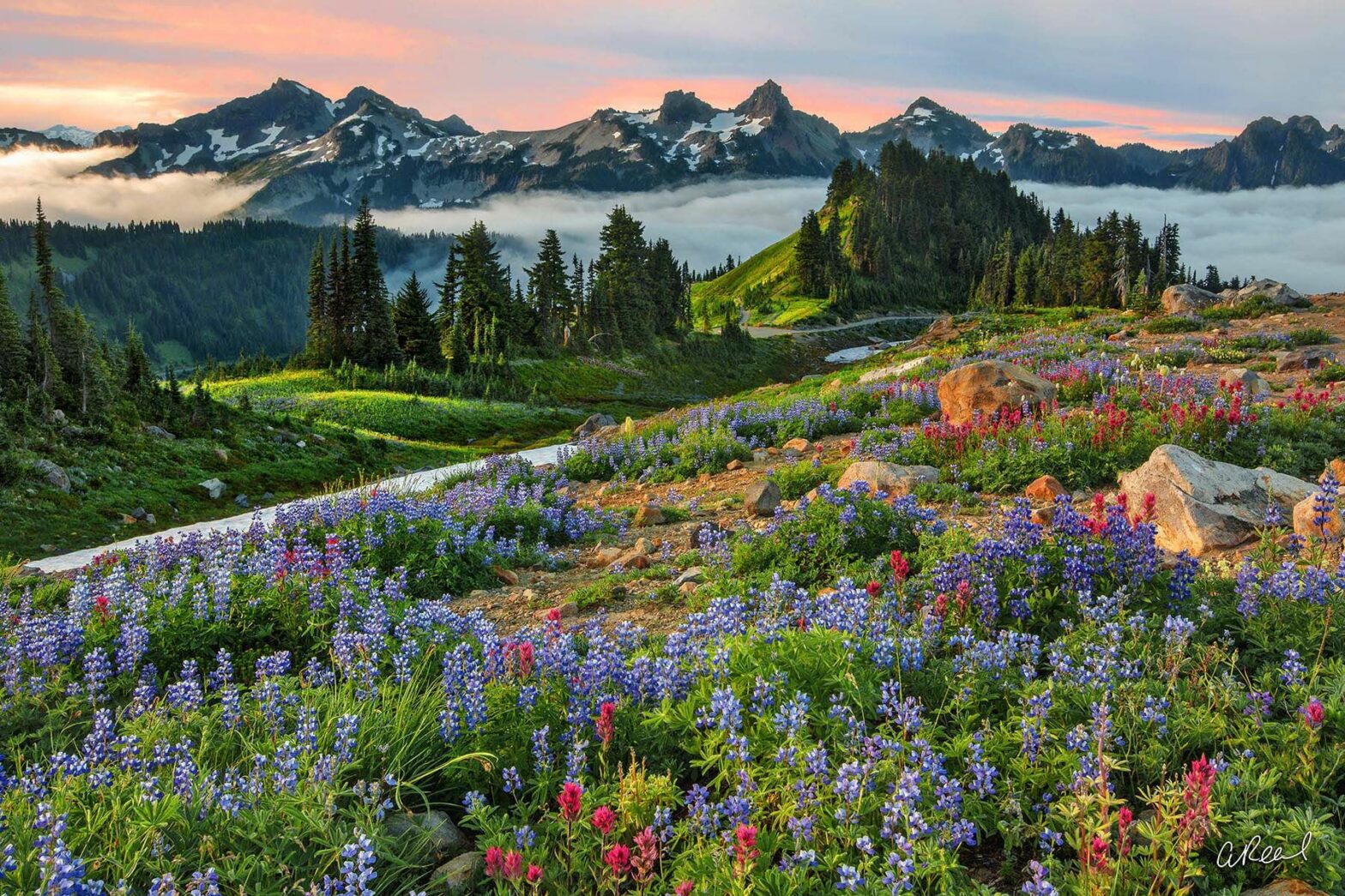[ad_1]
The mountains are calling and I must go.
Many of these articles highlight the natural wonders across the US, but many of them would not exist if it weren’t for the work put forth by conservationists. Our national parks were not always the federally protected lands they are today, and had it not been for environmentally conscious individuals pushing back against industrialists, we might never have had anything preserved.
Let’s take a look at the life and decades of work put forth by one of America’s most prominent conservationists, John Muir. If you’ve not yet heard of him, you’ll know soon enough that he was partly or wholly responsible for an impressive number of protected national parks across the country.
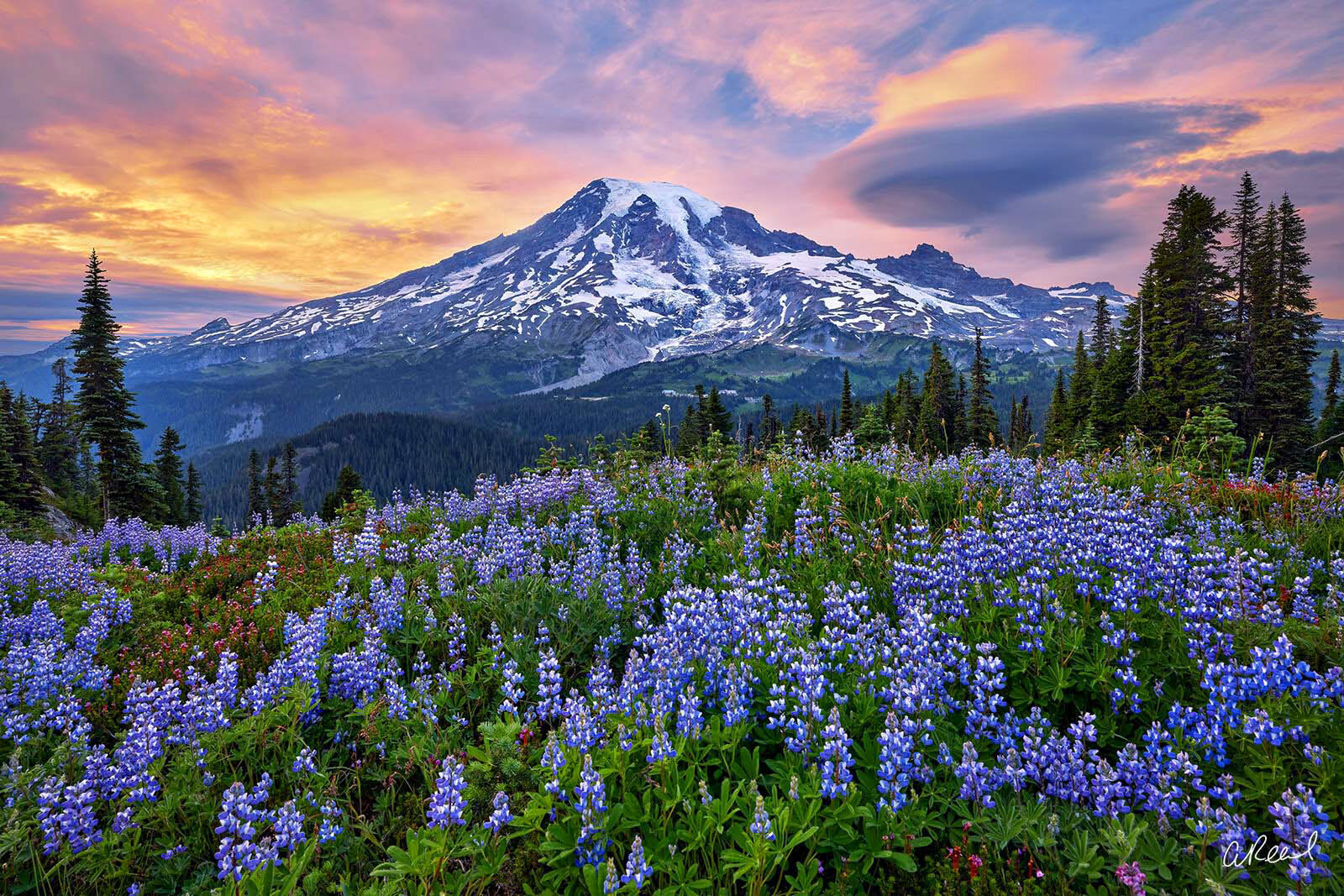
The whites and ingidos of an alpine meadow of lupine mirror the crags and glaciers of Mount Rainier National Park’s eponymous peak. The highest summit in the Pacific Northwest, the dormant volcano slumbers peacefully beneath the quiet grandeur of a midsummer sunset. Fine Art Limited Edition of 100.
The Life of John Muir | John of the Mountains
Despite being born in Scotland, John Muir was heavily involved in US forestry conservation efforts throughout his life. He left his home country at about the age of eleven to live and work on a Wisconsin farm with his family. Muir spent much of his youth working from sunrise to sunset, but in 1860, he left the farm to attend college in Madison.
He worked toward inventing machinery after finishing his schooling, but following an injury, he ceased inventing and started pursuing natural and creative efforts. He traveled throughout the US (and later the world), kept a journal about his adventures, wrote various articles that were published in popular magazines of the time, and put his heart into preserving the natural world.
John Muir died from pneumonia in 1914, in his seventies, but the effort he put into his passion for the outdoors is recognized even today.
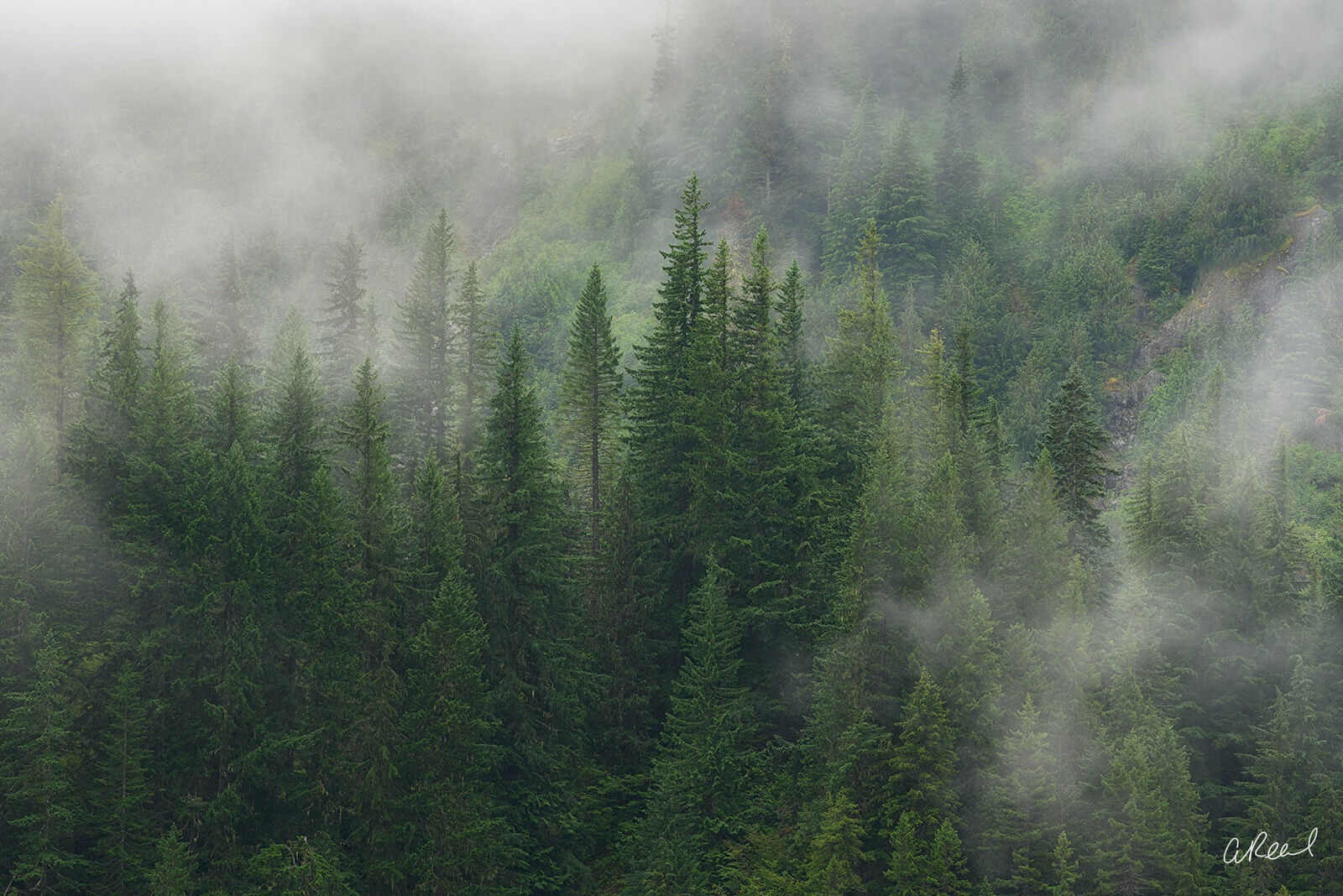
Wisps of fog drift silently down a lush hillside in the foothills of Mount Rainier National Park. Wraithlike, stands of fir and aromatic red cedar keep watch in the sheltered vales. Fine Art Limited Edition of 50.
“Between every two pine trees there is a door leading to a new way of life.”
John Muir Artistic Works
During his lifetime, John Muir wrote an impressive body of work, which included roughly 300 articles and ten full-length books that detailed his adventures, discussed his thoughts and feelings about nature, and encouraged others to take part in enjoying the great outdoors.
Some of his most popular books include A Thousand-Mile Walk to the Gulf, The Yosemite, Stickeen, Our National Parks, My First Summer in the Sierra, and The Mountains of California.
Essays and articles he penned were published in Century Magazine, Atlantic Monthly, the New York Tribune, and Harper’s Magazine (then called Harper’s New Monthly Magazine). Most of the topics of these articles involved the natural world in some way. Some were meant to display the appeal of the forests, others were written to note the behaviors of wild animals, and others still were originally letters from himself to friends, colleagues, and government leaders.
Some of Muir’s journals were released after his death as well, covering many of the experiences he had and thought-provoking philosophies that came to mind during his travels.
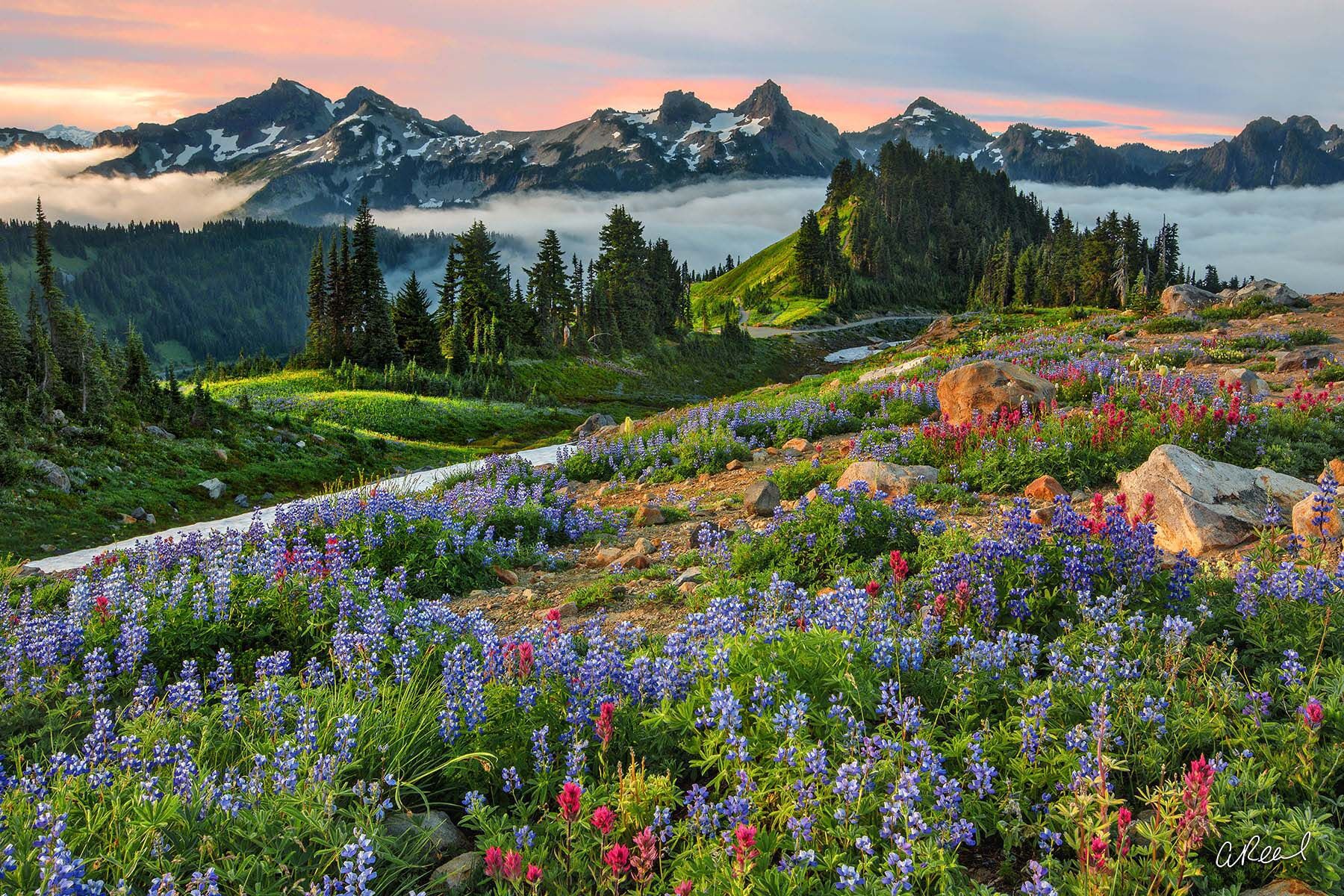
Liquid sun laps like the waves on a beach over a meadow of lupine and paintbrush in Mount Rainier National Park. Low banks of fog move through the valleys beneath the torn peaks of a dark mountain ridge, its snowy crags warmed by the embers of a dusky sky. Fine Art Limited Edition of 50.
“I only went out for a walk, and finally concluded to stay out till sundown, for going out, I found, was really going in.”
John Muir Preservation Efforts
Muir loved and respected the natural world, and the more he saw of it, the greater his resolve became. By 1876, he was already calling for conservation efforts to become law so that the vast forests of the US would have federal protections.
Unlike some conservationists of the time, like Gifford Pinchot, John Muir supported the complete preservation of national parks and forests, meaning that he was fully against the idea of allowing industrial interference. In his view, the natural world was one that should be off limits to those who sought to profit from any form of its destruction. This view was in contrast with conservationists who supported the idea of sustainable usage of various natural resources.
Muir’s writings were one of the driving forces behind pulling the public’s attention to the risks that came with the exploitation of the land, and his devotion to his cause helped bring the public’s opinion toward supporting conservation as well. The work he put into protecting national parks and forests helped cement the designation of 13 national forests in the US, and his influence helped spearhead the development of President Roosevelt’s conservation program.
Muir’s work also influenced the establishment of Mount Rainier as a national park in 1899 and the creation of the Grand Canyon National park in 1919, five years after his death.
However, it must be noted that Muir’s views toward the Indigenous Americans whose ancestors lived across the continent for centuries before settlers arrived were quite negative by today’s standards. Rather than showing support for the people whose very histories were entwined within the natural landscape, Muir was quite judgmental toward Native Americans. His opinions regarding Black Americans were not much better, as was unfortunately common in decades and centuries past.
Still, the results of his labor can’t be overlooked, as many of the national parks that exist today became a reality in some part due to John Muir. This includes Yosemite National Park, Sequoia National Park, the Petrified Forest, and as mentioned above, both Mount Rainier and the Grand Canyon National Parks.
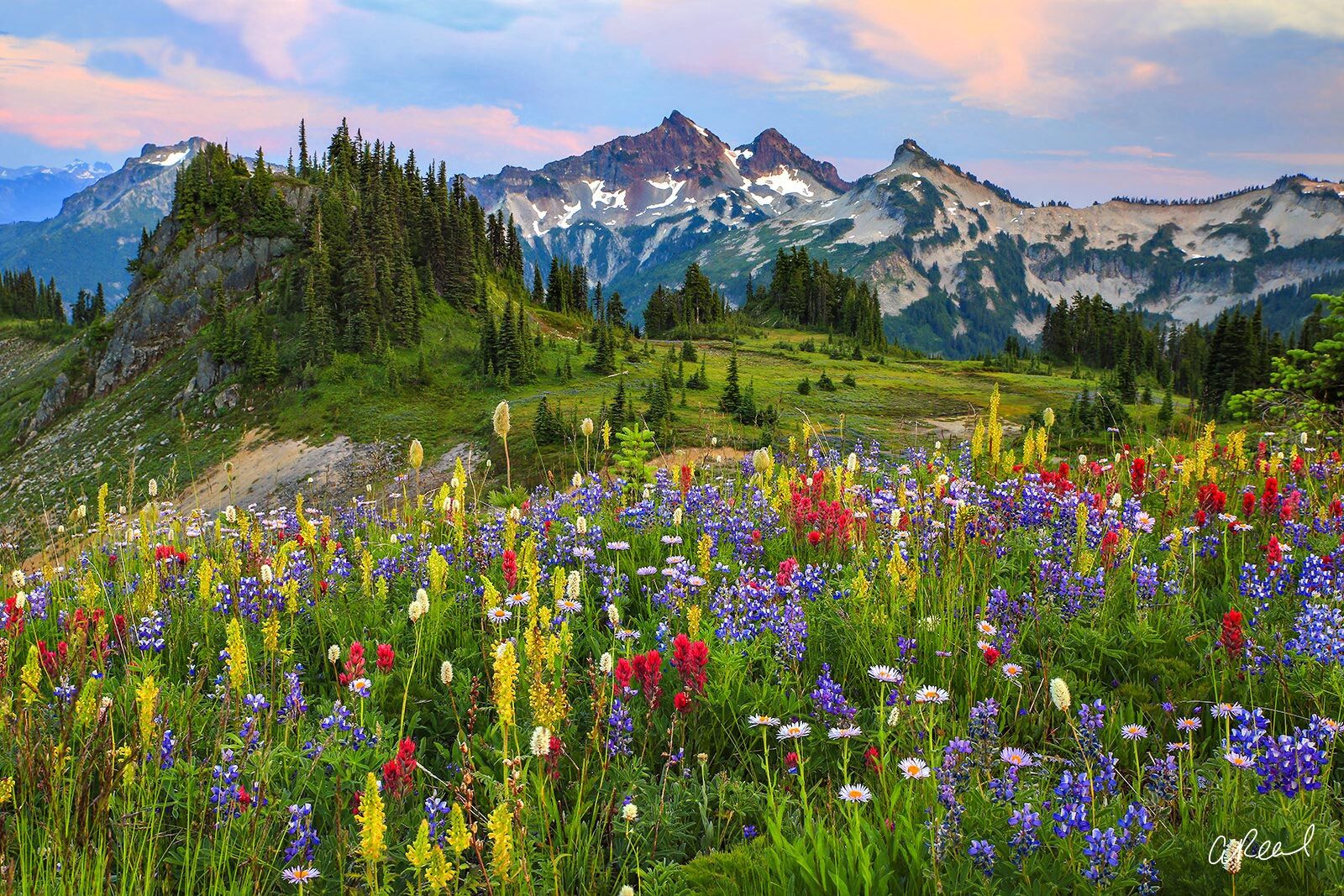
A dance of primary colors floods an alpine glade in the Cascade Mountains in Washington. A sunset navigates the troubled skies, painting the highest peaks of a ridge a deep velvety maroon. Fine Art Limited Edition of 50.
“The clearest way into the Universe is through a forest wilderness.”
John Muir Mt Rainier National Park
While generally associated with California’s High Sierra and Yosemite National Park, the Scottish-American naturalist, author and preservationist John Muir was also instrumental in the establishment of Mount Rainier National Park. In August of 1888 at the age of 50 he joined a climbing party which included Major Edward S. Ingraham, photographer Arthur Churchill Warner and guides Indian Henry and Philemon Beecher Van Trump for an ascent of the 14,411-foot volcano.
Muir’s group became the fifth recorded climbing party to have reached Rainier’s summit. But with Warner it became the first ascent documented by photography. Muir penned his experience in Ascent of Mount Rainier. The book along with Warner’s photos helped brought public awareness to the area and the need to protect it. And while Muir was impressed with being upon the mountain, he felt that it was better appreciated from below. He saw the value in preserving the area’s vast old-growth forests and pristine alpine meadows. In 1898 he wrote in The Wild Parks and Forest Reservations of the West, If in the making of the West, Nature had what we call parks in mind-places for rest, inspiration, and prayers -this Rainier region must surely be one of them.
On March 2, 1899, a little over a decade after Muir’s ascent, Mount Rainier became America’s fifth national park.
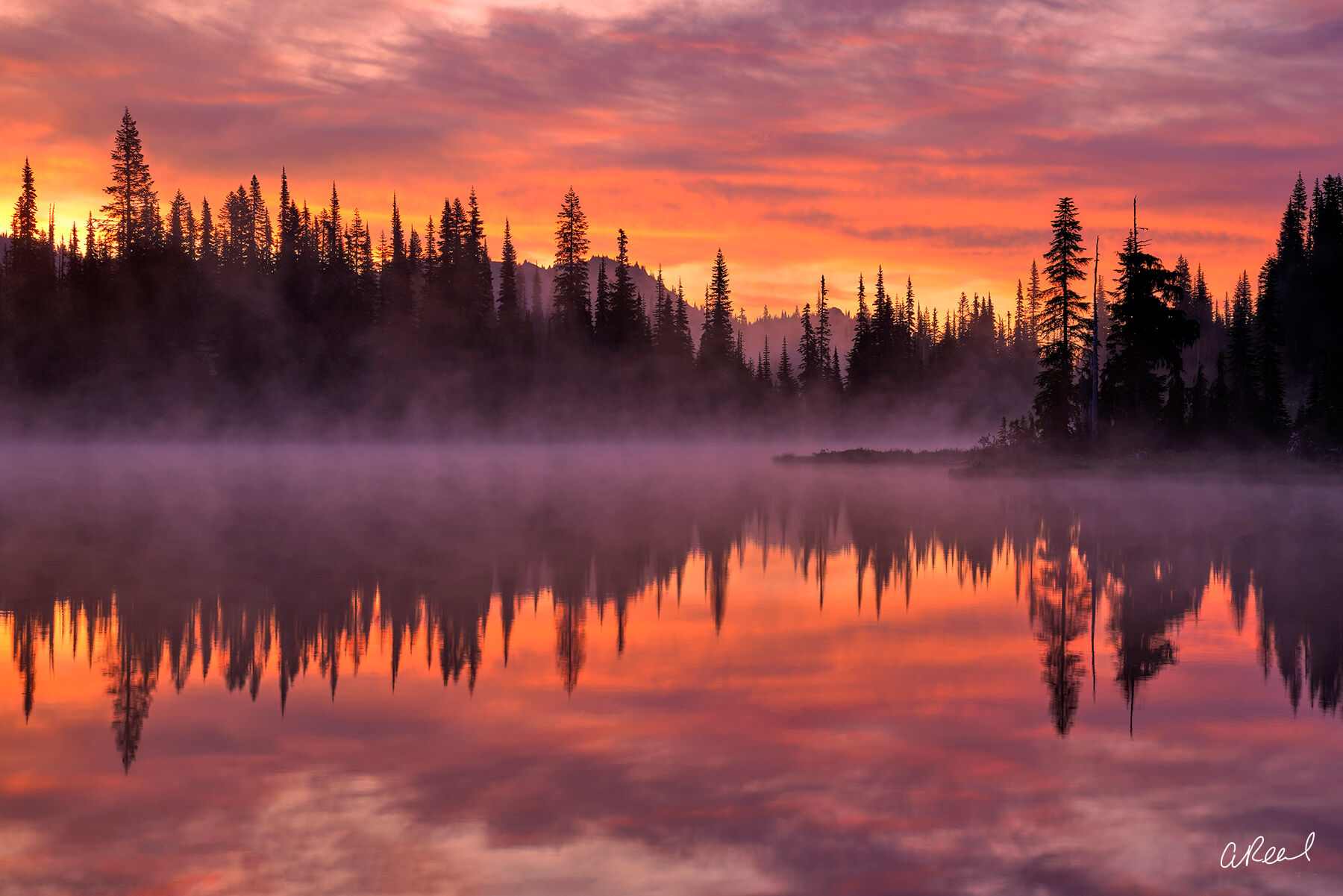
A chill dawn sets the sky alight behind the bristled silhouettes of a stand of cedar and fir. A ghostly mist hangs over the mirror-like surface of the lake, cloaking the shore in a veil of lavender. Fine Art Limited Edition of 50.
“…the most luxuriant and the most extravagantly beautiful of all the alpine gardens I ever beheld in all my mountain-top wanderings.”
The Sierra Club
One of Muir’s greatest achievements was founding the Sierra Club, an environmental organization that still exists today. In 1892, Muir, along with a group of other conservationists in California established the group and Muir served as the first president. It was a role he held until his death. The club was both a group for individuals who cared about preserving the natural world as well as a collection of activists who pushed back against efforts to reduce protections for national park lands. One of the group’s first missions involved stopping the push to decrease the size of Yosemite’s protected landmass.
Some of the group’s founding members included Joseph LeConte, Warren Olney, Willard Drake Johnson, and William Kieth. A couple of these names might be familiar, as LeConte and his colleague Henry Fairfield Osborn were deeply involved in the US’s eugenics movement.
Fortunately, the views of the time evolved and so did the club’s membership. The modern-day Sierra Club is far more inclusive and while it has distanced itself from the racism and antisemitism that put a blot on an otherwise fantastic cause, today’s leadership group acknowledges the issues of the past.
As of now, the Sierra Club is still at it, pushing for the protection of forests, parks, and wildlife. The club is a testament to the possibilities that can come to light when human beings work together toward a common good. The fact that the US has not been entirely destroyed to make way for factories, gated neighborhoods, and other business interests means that we owe the Sierra Club and its members a debt of gratitude.
So, the next time you’re out in nature, enjoying the wonder around you and taking in landscapes that only seem possible in paintings, take a moment to consider one of the many individuals who put their life’s work into preserving these beautiful places.
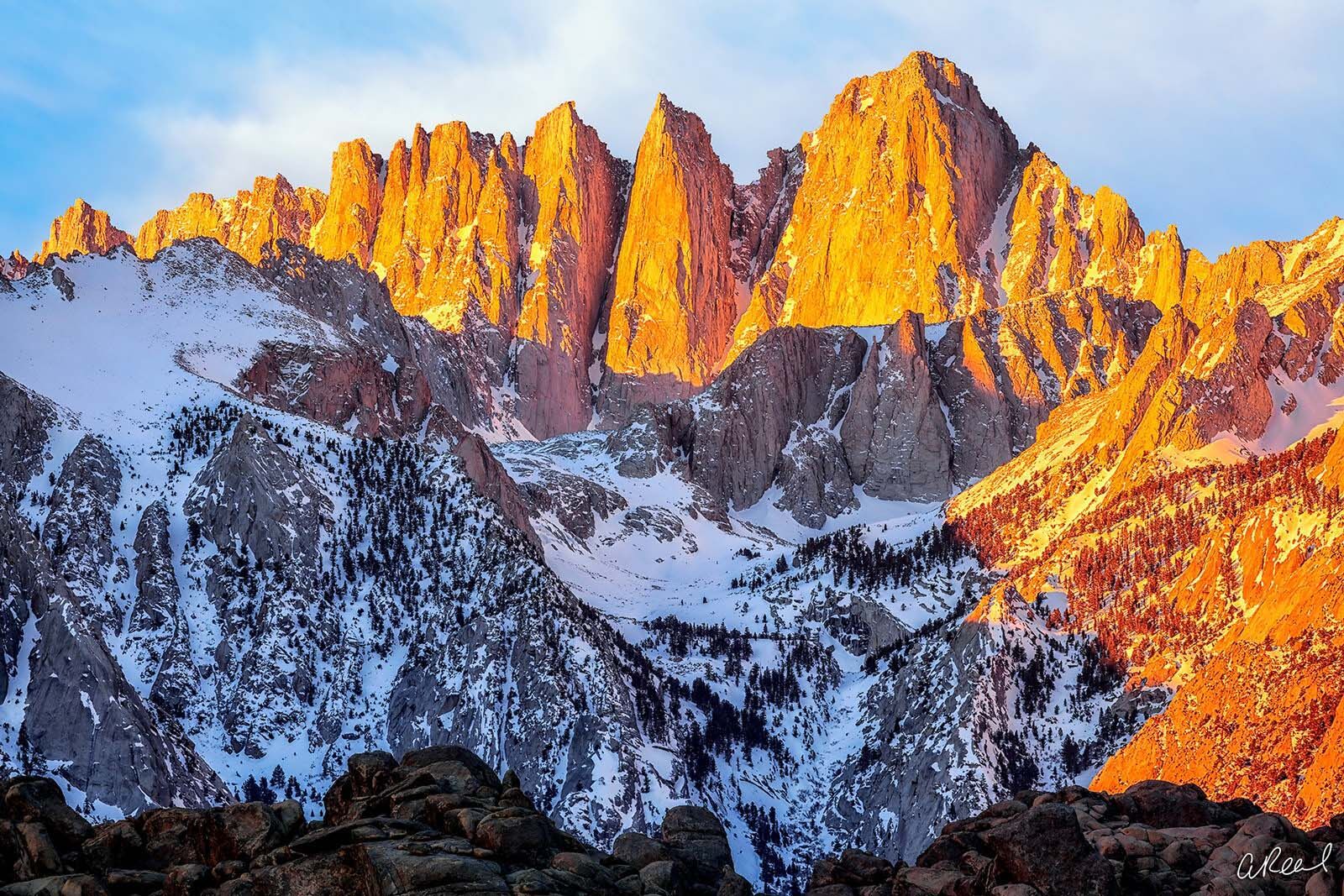
The jagged spires of Mount Whitney, highest peak in the contiguous U.S., are sparked to golden flame by the blaze of the dying sun. A wreath of snow and pitch-black pines drape the grand entrance to the cloudborne tower. Fine Art Limited Edition of 50.
[ad_2]
